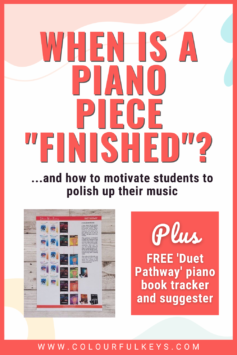It sounds like a funny question but it can be a tough one to answer. When is a student actually FINISHED with a particular piece? How do we know when it’s time to move on?

Each teacher has a different threshold for a student “passing off” or completing a piece, and there are dangers in going too far in either direction.
If you expect perfection on each and every piece, your students won’t get through much repertoire – which will hold back their reading and overall musical development.
If you move on too quickly, your students will be just skating the surface. They’ll never learn the polishing skills that take a piece from OK to good to great.
Personally, I like to start with why.
Set Piece Goals and Know the “Why“
It’s impossible to say whether a student has “finished” a piece if we don’t know why they’re learning it.
Hopefully, one of the reasons is that it’s a beautiful piece of music. Life’s too short to play boring things!
But as teachers, we usually have at least one other reason.
Sometimes, this is immediately apparent. For example, if a student is in a method book and sharps were just introduced, one of the main goals of this piece is probably to get used to using sharps.

Other times, it may take a bit more thinking.
- What skills does this student need to improve upon?
- What is top priority right now?
- Where are they in the learning process?
If we can properly articulate why the student is learning this piece or what we want them to get from it, we’re much better positioned to say when they’ve finished it.
Because there’s no such thing as perfect.
Basic Fluency
Now, regardless of the specific goals of a piece, one thing I generally want for every piece is a reasonable level of fluency. I want my student to be able to play the piece without stopping or backtracking.
A great way to measure this with students who are still in a method book is for the student to play along with the teacher duet part. If they can do that without my having to adjust my tempo a bunch of times, that means they know the piece fairly well.

Subscribe to updates and get Duet Pathway
Enter your details to subscribe to the newsletter for piano teachers with information, tips and offers.
I hate spam as much as you do! I’ll only send you information that’s directly relevant to music teachers and you can unsubscribe at any time.
Members of Vibrant Music Teaching can download the Duet Pathway resource directly from the library. Not a member? Take a tour of the membership to see what you’re missing out on!
This marker of fluency can be especially useful for those students who get impatient to move on to the next piece. It gives them a tangible goal so they’ll easily know when they’ve finished the piece.
There’s Always More
Certain pieces do need a pretty, shiny polish. If a student is learning them for a concert or exam, for instance, or if it’s a piece they truly adore, we should take care to get it to a very high level.
But there is always more we can do.
So I don’t think it’s necessary for every method book piece to be concert-worthy. We need to balance polishing skills with progress and movement through repertoire.
Dealing with Stagnation
Occasionally, even with specific and realistic goals for a piece, a student gets stuck.
You feel like it’s Groundhog Day every time they come to the lesson. You listen to the piece, work on it together and give the same recommendations for practice.
And you know you’re doomed to repeat this next week. I call this piece stagnation.
When this happens you have my permission to…
Let.
It.
Go.
I think as teachers, we can become a bit too dogged sometimes. We know that this student should be able to get this if they just put in the work.
But if they didn’t do that last week, or the week before, or the month before…they’re not going to do it this week.
So, either they just hate the piece and don’t practice it, or something isn’t clicking for them. Find another piece to teach the same concept and move on. You’ll both be happier for it.
When EVERY piece is stagnating
Now, if every piece is ending up stagnating and you never seem to achieve the goals with a particular student, one of 2 things is happening:
- They aren’t practising
- The material is too hard
Or both, of course.
If they’re not practising, we have many articles and resources to help you with that. I suggest starting with our practice hub.
If the material is too hard, you may need to change their books or add in a supplement. That’s ok! It doesn’t mean you’ve done anything wrong. That’s just part of teaching and individualising your lessons.

How do you know when your student has finished a piece?
I’d love to hear what “finished” means to you in the comments below.
For more amazing lesson-planning tips and resources, including suggestions for repertoire, check out my centralised page about planning music lessons.